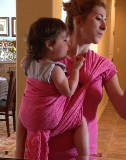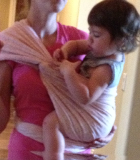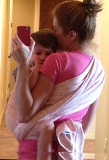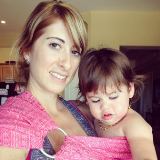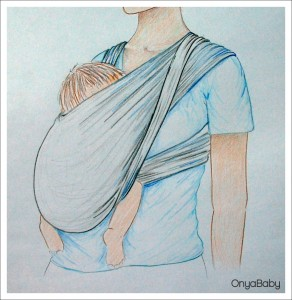Mei Tais, Podaegis (“Pod”), and Onbuhimos (“Onbu”)…these are all types of Asian-inspired baby carriers and offer babywearers some really amazing options for carrying their children on their front or back! They are perfect for newborns and are ideal for toddlerhood for back carries. In their simplest form, each of these carriers are essentially a rectangular cloth body with three different strap options depending on whether you will be using a Mei Tai, a Pod, or an Onbu.
Mei Tais are the most popular (and widely available) of the Asian-inspired carriers, so we will mostly discuss those. Information on Pods and Onbus can be found at the bottom of this post!
What is a Mei Tai?
“Mei Tais are a traditional Chinese baby carrier. In its very simplest form, a Mei Tai is a rectangular cloth body with straps coming off of each corner. Modern manufacturers have each developed their own take on this traditional design, so there is a wide variety of designs available…from wider panels, to padded straps, to custom creations made using woven wraps…the possibilities are endless for these amazingly functional and versatile baby carriers.
Mei Tais are most easily used for front and back carries (although they can be used for hip carries as well). Back carries can be done at varying heights (younger babies need a high back carry). They are easily transferred between wearers and provide a “custom” fit as they are tied onto the wearer and just live a woven wrap, adjust without buckles based on the wearer’s size.
Mei Tais are a good middle ground for someone who likes the custom fit that using a wrap offers but wants the speed and ease of a soft structured carrier.
Types of Mei Tais
Mei tais can be loosely categorized by strap style, waist style, and body type:
Strap Styles:
• Wrap Style Straps: These straps are un-padded and are worn on the shoulders much like a wrap would be.
• Padded Straps: These straps have some amount of padding on the part of the strap that goes over the shoulder. The rest of the strap is the same width but without padding.
• Padded to Wrap Straps: Found primarily on wrap conversions, padded to wrap straps start with padded shoulders but fan out to wrap width. Bamberoo’s “Hybrid” straps, Ocah’s “Duo” and “Harmony” straps, and ObiMama’s “Kombi” and “Zen” straps fall into this category.
Waist Styles:
• Un-padded: No padding on the waist.
• Padded: Some level of padding on the waist; padding may only be as wide as the body or may extend somewhat around the curve of the waist.
• Structured: Some mei tai makers offer a more structured waist like those found on soft structured carriers. These often have buckles; carriers with a buckle waist and tie straps are often referred to as half buckles.
Body Types and Other Features:
• Material: Most wraps are made from natural fiber materials; straps and inner bodies are generally heavy material like canvas. Most have coverings of print fabric. Some manufactures offer Solarveil carriers and others offer Wrap Conversions (either the body or the entire mei tai made from a woven wrap).
• Size: Some manufacturers offer different body sizes such as infant, standard, or toddler – check the measurements provided by the maker or ask if you are unsure about sizing. Other brands come in one size that is intended for all age babies/toddlers (although no Mei Tai offers a perfect fit from newborn to preschooler). Mei Tai width measurements are taken across the top of the waist band; height is measured from the top of the waistband to the top of the center of the carrier (usually it is specified if this measurement does or doesn’t include the headrest).
• Hoods and Headrests: Many Mei Tais offer hoods and/or headrests that can be used to support a baby’s head as she sleeps. Some hoods can be tucked into the Mei Tai or removed when not in use. Some are flat style and others designed like a sweatshirt hood.
• Body Styles: Some Mei Tais have a flat, rectangular body. Others offer seat darts and/or contoured bodies. Seat darts allow for a deeper seat and will accommodate a larger child than a non-darted body of the same width. Some wearers find that a non-darted body provides a more snug fit than one with darts.”
– Mei Tai information from “Becoming Mamas”, http://www.becomingmamas.com/babywearing/mei-tais/
What is an Onbuhimo?
An Onbuimo or “Onbu” is very similar to a Mai Tai, but instead of both shoulder and waist straps, it has shoulder straps and a pair of rings at the waist. The straps go over the wearer’s shoulders, then through the rings.

What is a Podaegi?
A Podeagi, or “Pod”is a traditional Korean-inspired Asian baby carrier that is also similar to a Mei Tai. Unlike a Mei Tai, a Podaegi only has two straps, located at the top of the carrier. It can have either a large, blanket like body, or a narrower body similar to a Mei Tai in size. As a back carrier, the Pod is ideal for use with pregnant moms or moms who are still recovering from a c-section as there is not a waist strap and can be safely secured using the shoulder straps.

Stop by our Pinterest Boards for information on some brands of Mei Tais that are widely available:
…and for videos on how to use Mei Tais and other Asian-inspired baby carriers!!






